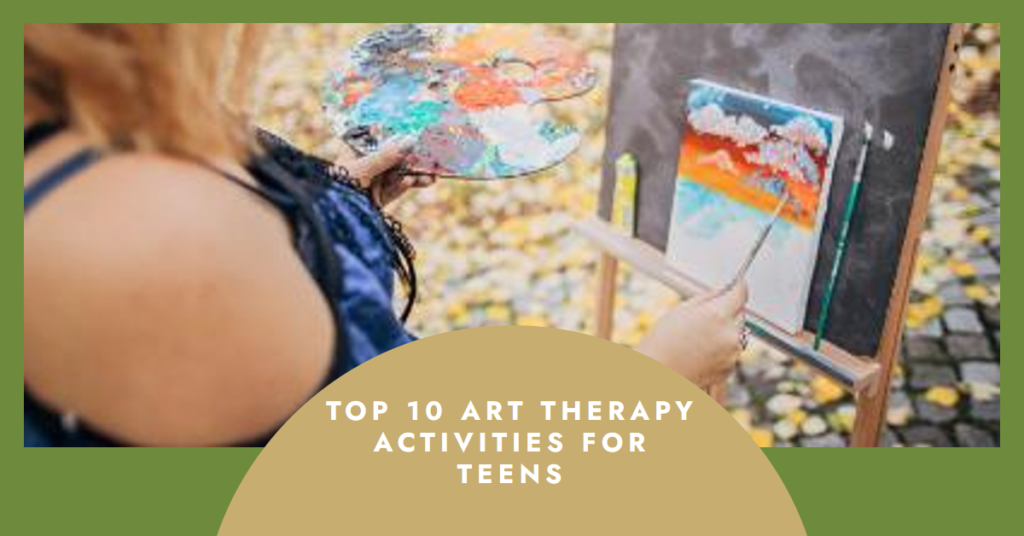Clinical vs. Non-Clinical Art Therapy: A Comprehensive Guide to Understanding the Differences

Art therapy is a powerful therapeutic approach that combines creativity and psychology to help people express their thoughts and emotions. It is utilized in various settings, including clinical and non-clinical environments. In this article, we will explore the differences between clinical and non-clinical art therapy, the benefits of each, and the essential factors to consider when selecting the right art therapy approach.

What is Clinical Art Therapy?
Clinical art therapy is a form of psychotherapy that uses art as a medium to address psychological and emotional issues. It is conducted by a licensed art therapist who has specialized training in using art materials and creative processes to promote healing and growth.
Characteristics of Clinical Art Therapy
- Structured Environment: Clinical art therapy takes place in a controlled and structured setting, such as a hospital, clinic, or mental health facility. This allows the therapist to monitor the client’s progress closely and provide tailored support.
- Diagnostic Assessment: The art therapist assesses the client’s needs and formulates a treatment plan based on their psychological and emotional challenges. This involves using art-based assessments to identify the client’s strengths and areas of improvement.
- Goal-Oriented Approach: The art therapist sets specific therapeutic goals for the client and uses various art techniques and interventions to help them achieve these goals. This may include enhancing self-awareness, improving communication skills, or addressing trauma.
What is Non-Clinical Art Therapy?
Non-clinical art therapy, also known as community-based art therapy, focuses on fostering creativity, self-expression, and personal growth. It is typically offered in non-medical settings such as schools, community centers, and private studios.
Characteristics of Non-Clinical Art Therapy
- Informal Environment: Non-clinical art therapy takes place in a more relaxed and informal setting. This encourages participants to explore their creativity and self-expression without the pressure of a clinical environment.
- Group Dynamics: Non-clinical art therapy often involves group sessions where participants can connect with others and share their experiences. This fosters a sense of belonging and helps build social support networks.
- Self-Discovery and Empowerment: The primary focus of non-clinical art therapy is on personal growth and self-exploration. Participants are encouraged to use art as a means of self-expression and self-discovery, which can lead to increased self-esteem and personal empowerment.
Benefits of Clinical vs. Non-Clinical Art Therapy
Both clinical and non-clinical art therapy approaches offer unique benefits that cater to different needs and preferences.
Advantages of Clinical Art Therapy
- Targeted Interventions: Clinical art therapy is tailored to address specific psychological and emotional issues, providing targeted support for individuals in need.
- Professional Guidance: The expertise of a licensed art therapist ensures that clients receive the appropriate therapeutic interventions and support.
- Measurable Progress: The goal-oriented nature of clinical art therapy allows clients and therapists to track progress and make adjustments to the treatment plan as needed.
Advantages of Non-Clinical Art Therapy
- Stress Relief: Non-clinical art therapy provides a creative outlet for individuals to express their emotions and reduce stress.
- Community Connection: Group sessions in non-clinical art therapy can help individuals build social connections and foster a sense of belonging.
- Personal Growth: The emphasis on self-discovery and empowerment in non-clinical art therapy can lead to increased self-awareness and personal development.
Licensing and Certification for Art Therapists in the USA, Canada, and Australia
The requirements for licensing and certification for art therapists vary across countries. In this section, we will discuss the primary credentials and qualifications for art therapists in the United States, Canada, and Australia.
Licensing and Certification in the United States
In the United States, the primary credential for art therapists is the Registered Art Therapist (ATR) or the Board Certified Art Therapist (ATR-BC) designation, which is awarded by the Art Therapy Credentials Board (ATCB). To obtain these credentials, art therapists must meet the following criteria:
- A master’s degree in art therapy or a related field from an accredited institution.
- Completion of supervised clinical experience, ranging from 1,000 to 2,000 hours, depending on the specific requirements of the credential.
- Successful completion of the ATCB examination (for ATR-BC designation).
It is essential to note that licensing requirements for art therapists vary by state. Some states have specific licensure for art therapists, while others may require art therapists to obtain a license as a professional counselor or marriage and family therapist.
Licensing and Certification in Canada
In Canada, the Canadian Art Therapy Association (CATA) is the primary organization responsible for credentialing art therapists. To become a Professional Member of CATA, applicants must meet the following requirements:
- A master’s degree in art therapy from an accredited institution or a graduate-level diploma in art therapy, along with a master’s degree in a related field.
- A minimum of 700 hours of supervised clinical experience, including 350 hours of direct client contact.
- Adherence to the CATA Code of Ethics and Standards of Practice.
CATA does not provide licensure for art therapists; instead, it offers a voluntary registration process. However, some provinces may have specific licensure requirements for practicing art therapists.
Licensing and Certification in Australia
In Australia, the Australian, New Zealand, and Asian Creative Arts Therapies Association (ANZACATA) is responsible for regulating and accrediting art therapists. To become a Professional Member of ANZACATA, applicants must fulfill the following requirements:
- A master’s degree in art therapy or a related field from an accredited institution.
- Completion of a minimum of 750 hours of supervised clinical experience, including at least 350 hours of direct client contact.
- Compliance with ANZACATA’s Code of Ethics and Professional Standards.
Similar to Canada, Australia does not have a national licensure system for art therapists. Instead, the ANZACATA registration serves as a credential demonstrating the therapist’s qualifications and adherence to professional standards.
Table: Licensing and Certification for Art Therapists in the USA, Canada, and Australia
| Country | Licensing/Certification Body | Primary Credential | Requirements |
|---|---|---|---|
| USA | Art Therapy Credentials Board (ATCB) | Registered Art Therapist (ATR) or Board Certified Art Therapist (ATR-BC) | – Master’s degree in art therapy or a related field from an accredited institution. – 1,000 to 2,000 hours of supervised clinical experience. – Successful completion of the ATCB examination (for ATR-BC designation). – State-specific licensure requirements may apply. |
| Canada | Canadian Art Therapy Association (CATA) | Professional Member of CATA | – Master’s degree in art therapy from an accredited institution or a graduate-level diploma in art therapy, along with a master’s degree in a related field. – Minimum of 700 hours of supervised clinical experience, including 350 hours of direct client contact.<br> – Adherence to the CATA Code of Ethics and Standards of Practice.<br> – Provincial licensure requirements may apply. |
| Australia | Australian, New Zealand, and Asian Creative Arts Therapies Association (ANZACATA) | Professional Member of ANZACATA | – Master’s degree in art therapy or a related field from an accredited institution. – Minimum of 750 hours of supervised clinical experience, including at least 350 hours of direct client contact. – Compliance with ANZACATA’s Code of Ethics and Professional Standards. |
Non-Clinical Art Therapy Certifications
While the primary focus of licensure and certification is on clinical art therapy, non-clinical art therapy practitioners can also benefit from obtaining relevant qualifications. These certifications demonstrate their expertise in using art for self-expression, personal growth, and community development. Below, we will discuss some certifications available for non-clinical art therapy practitioners.
Expressive Arts Therapy Certifications
Expressive arts therapy is an interdisciplinary approach that integrates various creative modalities, such as visual arts, music, dance, and writing, to foster self-expression and personal growth. Several institutions and organizations offer certifications in expressive arts therapy, which can benefit non-clinical art therapy practitioners. To obtain these certifications, applicants typically need to complete coursework and supervised practice in expressive arts therapy.
Art Facilitator Certifications
Art facilitators guide individuals or groups through creative processes in non-clinical settings, such as community centers, schools, and private studios. Several organizations offer art facilitator certifications, which require applicants to complete training programs covering various art techniques, group dynamics, and facilitation skills. These certifications can help non-clinical art therapy practitioners demonstrate their expertise in leading creative workshops and fostering a supportive environment for self-expression and personal growth. Make sure you always embrace your non-clinical role.
Choosing the Right Art Therapy Approach
When selecting the appropriate art therapy approach, consider the following factors:
- Individual Needs: Evaluate the individual’s specific emotional and psychological needs to determine which approach would be most beneficial.
- Therapist Credentials: Ensure that the art therapist is licensed and has the necessary training to provide the appropriate level of support.
- Setting and Atmosphere: Consider whether a structured clinical environment or a more relaxed non-clinical setting would be a better fit for the individual.
- Group vs. Individual Sessions: Determine whether the person would benefit more from one-on-one sessions with a therapist or from the social dynamics of a group setting.
- Goals and Expectations: Clarify the objectives of the therapy and assess which approach aligns best with the desired outcomes.
Comparison Table: Clinical vs. Non-Clinical Art Therapy
| Feature | Clinical Art Therapy | Non-Clinical Art Therapy |
|---|---|---|
| Environment | Structured and controlled | Relaxed and informal |
| Therapist Credentials | Licensed and trained professionals | Varies; may not require licensure |
| Session Focus | Psychological and emotional issues | Creativity and self-expression |
| Assessment and Treatment Plan | Diagnostic assessment and treatment plan | Not applicable |
| Approach | Goal-oriented | Self-discovery and empowerment |
| Setting | Hospitals, clinics, mental health facilities | Schools, community centers, private studios |
| Session Type | Individual or group sessions | Typically group sessions |
Conclusion
In summary, clinical and non-clinical art therapy serve different purposes and cater to various needs. Clinical art therapy is designed to address specific psychological and emotional challenges within a structured and professional environment. In contrast, non-clinical art therapy focuses on personal growth, creativity, and self-expression in a more relaxed setting. By understanding the differences between these two approaches, individuals can make informed decisions about which art therapy approach is best suited for their unique needs and goals.
If you’re interested in becoming an art therapy practitioner, we invite you to register for our online Art Therapy Practitioner Training Course. Our comprehensive program will equip you with the knowledge and skills needed to excel in either a clinical or non-clinical role, allowing you to provide the appropriate level of support and guidance for your clients. Enroll today and embark on a rewarding journey as an art therapy practitioner, helping individuals achieve emotional well-being and personal growth through the transformative power of art.
Frequently Asked Questions (FAQs)
Q: What is the primary difference between clinical and non-clinical art therapy?
A: The primary difference lies in their focus and approach. Clinical art therapy addresses specific psychological and emotional issues in a structured environment, while non-clinical art therapy focuses on personal growth, creativity, and self-expression in a more relaxed setting.
Q: Can art therapists work in both clinical and non-clinical settings?
A: Yes, art therapists can work in both settings. However, it’s essential for them to have the appropriate licensure and training to provide clinical art therapy services.
Q: Is art therapy only for people with mental health issues?
A: No, art therapy can benefit anyone looking for an outlet for self-expression, stress relief, and personal growth. While clinical art therapy specifically addresses mental health issues, non-clinical art therapy is suitable for individuals seeking creative exploration and community connection.
Q: How do I find a qualified art therapist?
A: To find a qualified art therapist, search for professionals who are registered or board-certified by reputable organizations such as the American Art Therapy Association (AATA) or the Art Therapy Credentials Board (ATCB).
Q: How long does it take to see results from art therapy?
A: The duration of art therapy depends on the individual’s needs, goals, and the specific approach taken. Progress in clinical art therapy can be measured and adjusted, while non-clinical art therapy often focuses on personal growth and self-discovery, which can take time to unfold.










Responses